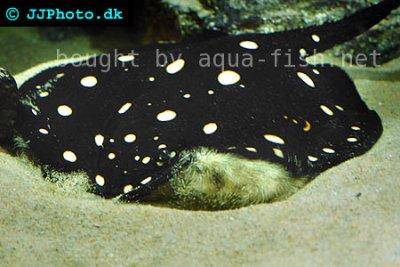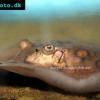Yellowspotted river stingray - Potamotrygon leopoldi
Scientific name: Potamotrygon leopoldi
Common name: Yellowspotted river stingray
Family: Potamotrygonidae
Usual size in fish tanks: 38 - 43 cm (14.96 - 16.93 inch)
014
Recommended pH range: 6 - 7
Recommended water hardness: 4 - 12°N (71.43 - 214.29ppm)
0°C 32°F30°C 86°F
Recommended temperature range: 21 - 25 °C (69.8 - 77°F)
The way how these fish reproduce: Spawning
Where the species comes from: South America
Temperament to its own species: peaceful
Temperament toward other fish species: peaceful
Usual place in the tank: Bottom levels
Food and feeding
Yellowspotted river stingrays are carnivores so meaty foods are required. They will accept all live or frozen foods and they are very partial to a meal of shrimps. Other foods that will be accepted are earthworms, mealworms, cockles and mussels.
Origin
South America; Yellowspotted river stingrays are found in the Xingu River Basins.
Sexing
Males have modified ventral fins that can be seen from underneath the fish, these are absent in the females.
Breeding
When breeding is about to occur the male will bite the female, this is normal and part of the courtship, because of this behaviour always keep a larger female than the male. When ready to spawn the male will mount the female and clasp her with his ventral fins and insemination will take place if she is ready. The eggs are held for about 100 days and the “pups” are live born after this.
Lifespan
The expected life span of Potamotrygon leopoldi is 5-15 years.
Short description
Potamotrygon leopoldi need lots of space in the tank to swim. The minimum tank size is 100 gallons and a large footprint is required more than depth of the tank. They spend most of their time on the bottom of the tank but they will rise to the surface to feed.Also known as White-blotched river stingray (fishbase).
Pictures
Bought by aqua-fish.net from jjphoto.dk.







 Ocellate
Ocellate